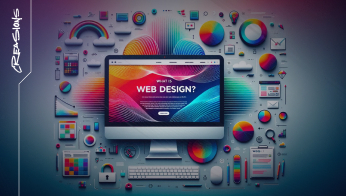
Web designing is the process of creating and maintaining the visual and functional aspects of a website. It involves planning, conceptualizing, and arranging content in a way that enhances user experience and meets specific aesthetic and functional requirements. Web design encompasses various elements, including layout, colors, fonts, images, graphics, and interactive features that make a website visually appealing and easy to navigate.
Key Components of Web Design
-
Layout
The layout refers to how information is structured and presented on a webpage. This includes the placement of text, images, and navigation elements. A good layout ensures that content is organized logically and is easy for users to follow.
-
Color Scheme
The color scheme involves choosing a palette of colors that align with the brand’s identity and create a pleasing visual experience. Colors can evoke emotions and influence how users perceive a website, so they are a critical aspect of web design. -
Typography
Typography deals with the selection and styling of fonts. The choice of fonts can affect readability and convey the personality of the website. Designers must choose fonts that are easy to read across different devices and screen sizes.
-
Graphics and Images
Graphics and images are visual elements that enhance the appeal of a website and help convey information effectively. This includes icons, illustrations, photos, and videos. Proper use of graphics and images can make a website more engaging and informative.
-
Navigation
Navigation is the method by which users move around a website. Good navigation design helps users find the information they are looking for quickly and easily. This includes menus, buttons, and internal links that guide users through the site. -
Content
Content is the information presented on a website, including text, images, videos, and other multimedia elements. High-quality, relevant content is crucial for engaging users and delivering the website’s message effectively.
-
User Experience (UX) Design
UX design focuses on creating a positive experience for users by ensuring that the website is easy to use, intuitive, and meets users’ needs. It involves understanding user behavior, designing interactive elements, and optimizing the overall functionality of the website.
-
Responsive Design
Responsive design ensures that a website looks and functions well on various devices, such as desktops, tablets, and smartphones. This involves using flexible layouts, images, and CSS media queries to adapt to different screen sizes and resolutions.
Why is Web Design Important?
Web design is important because it directly impacts how users perceive a website and, by extension, the brand or business it represents. A well-designed website can enhance user engagement, improve conversion rates, and foster trust and credibility. Here are a few reasons why web design matters:
- First Impressions: The design of a website is often the first interaction a user has with a brand. A professional and visually appealing website can create a positive first impression and encourage users to explore further.
- Usability and Accessibility: Good web design ensures that a website is easy to use and accessible to all users, including those with disabilities. This increases the website’s reach and provides a better experience for all visitors.
- SEO and Visibility: Web design affects how content is structured and presented, which can impact search engine optimization (SEO). A well-designed website that follows SEO best practices can rank higher in search engine results, increasing visibility and traffic.
- Branding and Credibility: Consistent design elements, such as colors, fonts, and imagery, help establish a strong brand identity. A cohesive and professional design can build trust and credibility with users, making them more likely to engage with the content and take desired actions.
- Conversion and Engagement: Effective web design can guide users toward specific actions, such as signing up for a newsletter, making a purchase, or contacting a business. By creating a clear and intuitive path, web design can improve conversion rates and engagement.
Wide-Up:
Web design is a crucial aspect of building an effective online presence. It involves more than just aesthetics; it’s about creating a user-friendly, accessible, and engaging experience that aligns with a brand’s goals and values. Whether you’re designing a personal blog or a complex e-commerce site, understanding the principles of web design can help you create a website that not only looks good but also performs well.









